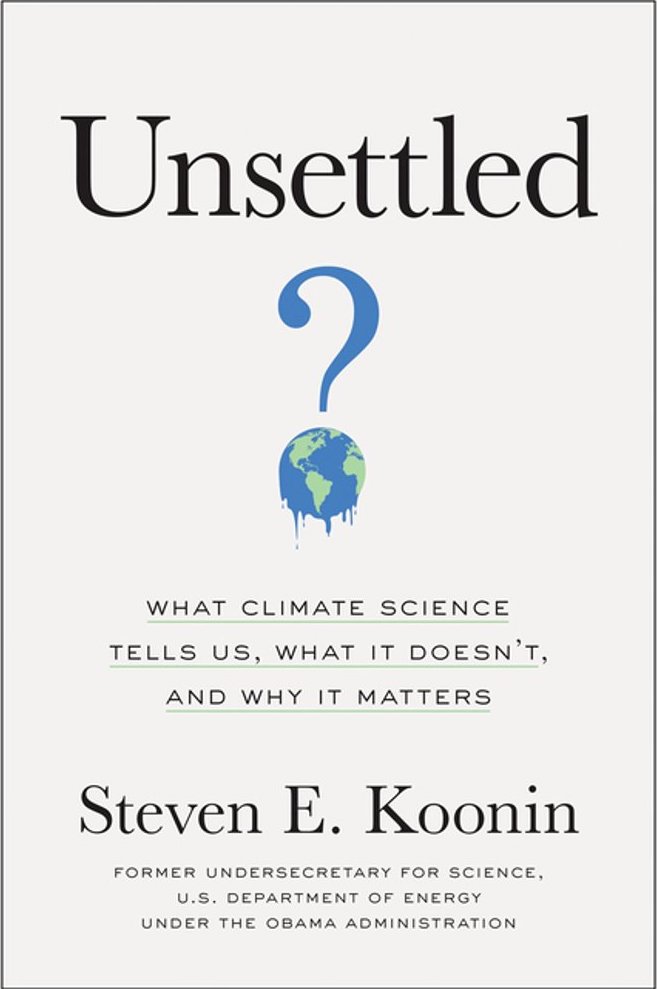Unsettled is a highly scientific look at the strengths and weaknesses of climate modeling, common issues with weather and climate data, and gaps in our scientific knowledge. Running counter to the doomsday rhetoric we encounter at nearly every turn, I found Unsettled to be a pleasant (if a bit dry) reminder of the difference between anecdotal evidence supporting a narrative, and scientifically derived findings. To be clear, Koonin is not a climate denier. He is clear that climate change is happening, and that human impacts are an important factor. The argument put forward in his book, however, is that we, as a population, based on the journalistic reporting of well chosen facts displayed as sensational headlines, are in danger of jumping to conclusions about the relationships between observed changes in our weather patterns, and the underlying climate cycle.
First, Koonin tackles the difference between weather and climate. He challenges readers to consider context when consuming dramatic headlines. He presents several examples in his book, and that analysis has helped me to be more thoughtful and considerate when I consume daily headlines, such as “Climate crisis study finds heatwaves have cost global economy $16tn”, Guardian, Oct 2022.
Realistically, this cannot be a climate crisis study, as it only looks at weather patterns from the last 40 years. Climate, on the other hand, is a concept that describes changes over periods of tens of thousands of years. For example, Milankovich, a Serbian Scientist, observed that significant climate changes (measured by the occurrence of Ice Ages) can be observed on a 100,000 year cycle over the last 800,000 years. If we are in climate cycles spanning 100,000 years, weather patterns over the last 40 years cannot be considered indicative of changing climate cycles simply because they represent such a small percentage of cycle time.
The other troubling element of this headline is that the words “climate crisis study” causes us to make assumptions. Did you assume this was a scientific study (and by “scientific” I mean specifically a study relying on the scientific method associated with study of the natural world)? It is not – it is an econometric study of the financial impact of recent weather events described by its authors as “climate-economic” research. None of these things mean that the headline is technically inaccurate nor that this study is unscientific. Let me be clear, this is a very important economic study of the impact of recent weather events on the population. My point is that the details of what is being studied and how are lost between the article published in Science Advances magazine, and the Guardian headline sensationalizing it.
What is important here is the distinction between weather and climate, and the distinction between scientific observation and economic modeling that Koonin’s analysis helps us to consider when consuming news media. There is a substantial difference between natural science based studies of our environment and research estimating the economic impact of certain events. This is not to say that one is lesser or greater than the other – merely that they are different. The principle of these differences can often be found in the mathematical range of findings associated with economic estimates. The authors of the study referred to in the Guardian headline put forward: “Cumulative 1992–2013 losses from anthropogenic extreme heat likely fall between $5 trillion and $29.3 trillion globally.” That very wide interval reflects the uncertainty associated with the number $16tn. However, that range, and the uncertainty are not mentioned in the Guardian article. In fact, if you read the scientific article, the authors are quite clear about the limitations of data and at no point do they suggest that their data reflects climate patterns – they are very clear that their data reflect weather patterns.
Unsettled offers invaluable insight into how messages are perverted as they traverse from scientific publication to newspaper headlines. Koonin adeptly articulates the difference between scientific findings in the study of climate change and climate modeling: predicting the future of temperature and weather patterns, which is a concept seemingly forgotten all to often in journalistic publications.
The former, scientific findings, reflect what we can observe, with scientific method, in the world today. These include significant increases in temperature over time. The latter, predicting of future weather patterns, is not limited to scientific method of observation, but applies historically observed patterns, and applies them to the future with the aid of computer based modeling. There is a huge leap inherent in this type of modeling that seems to be lost on journalists and the public: the number of assumptions one must make in order to build a predictive model gives the modeler an unbelievable amount of creative license. Koonin explores this with deep knowledge of the available scientific data and the modeling process and presents clear examples of the pitfalls and limitations of some of these data.
Sources:
https://www.theguardian.com/environment/2022/oct/28/climate-crisis-heatwaves-cost-global-economy
https://www.science.org/doi/10.1126/sciadv.add3726

 Doughnut Economics
Doughnut Economics Sustainable Beauty: Practical Advice and Projects for an Eco-conscious Beauty Routine
Sustainable Beauty: Practical Advice and Projects for an Eco-conscious Beauty Routine